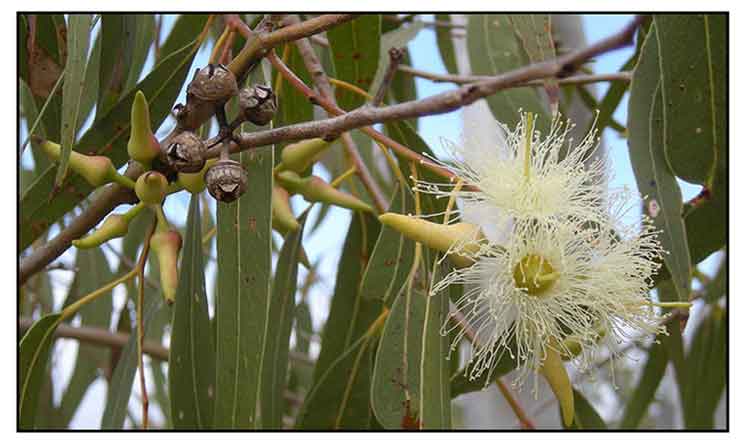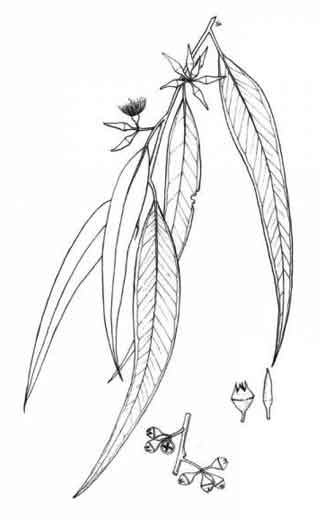 Botany Botany
Eucalyptus tereticornis is a tree reaching a height of 15 meters or more in the Philippines. Trunk is usually straight and at least half the total height. Crown is large and somewhat open. Bark is grayish and peels off in thin layers. Leaves are leathery, lanceolate, somewhat sickle-shaped, and 10 to 25 centimeters i length. Peduncles are axillary or lateral and up to 1.5 centimeters long, each bearing 3 to 5 short-peduncled flowers. Flowers are white, about 1.5 centimeters in diameter, in small clusters. Fruit is obovoid or somewhat rounded, about 8 millimeters in diameter.
 Distribution Distribution
- Cultivated in Manila and other large towns.
- Grows vigorously in Baguio.
- Native of Australia.
- Also occurs in Papua New Guinea and India.
- Introduced to many tropical and subtropical countries in Africa, Asia, and South America.
- Used for reforestation and as shelter or shade tree.
Constituents
- Particular species giving highest yields of eucalyptus oil were E. gloublus, E. tereticornis, E. polyanthemos, and E. citriodora.
- Qualitative analysis of leaf extract yielded biologically active compounds - tannins, alkaloids, flavonoids, and steroids/triterpenes.
- Methanol extract yielded ursolic acid.
- Study of essential oil yielded: total citronelal (44.8%) and geraniol (9.78%).
Two fractions were composed mostly of p-mentane-3,8-diol (18.95%) and geraniol acetate (24.34%).
- Phytochemical screening of methanol extract of bark and leaves yielded saponins tannins, steroids, and flavonoids; only the bark extract yielded cardiac glycosides. (see study below)
(10)
- Analysis of essential oil hydrodistilled from fresh and decaying leaves by GC-MS identified a total of 68 constituents. Major constituents of fresh leaf oil were α-pinene (28.53%) and 1,8-cineole (19.48%), whereas decaying leaves yielded ß-citronellal (14.15%), (-)-isopulegol (13.35%), and (+)-ß-citronellol (10.73%). (see study below) (17)
Properties
- Stimulant, anesthetic, antiseptic, vulnerary.
- Studies have shown antibacterial, antihyperglycemic, antioxidant, hepatoprotective, anti-inflammatory, anti-filarial properties.
Parts used
Oil, leaves.
Uses
Edibility
- A major source of pollen and nectar, producing a caramel-flavored honey. (13)
-
As bush food, gum put in solution and drunk, nectar is sucked from the flowers, and water extracted from the roots.
Folkloric
- Eucalyptus oil is used extensively in medicine.
- Eucalyptol is used internally and externally. Internally it is used as a stimulant. Locally, it possesses mildly antiseptic and anesthetic properties.
- As Bush medicine, used for treatment of diarrhea and dysentery. Leaves chewed and placed on wounds to facilitate healing.
- Decoction of leaves used to reduce fever and alleviate pulmonary problems. (13)
Others
- Firewood: Wood is hard, heavy, and strong. It produces first class fuel-wood and makes good charcoal.
- Wood:
One of the most durable of timbers, immune to termites and dry rot. Valued for underground construction, poles, posts, fiberboard and particle board.
- Pulp: Considered one of the best trees for fiber for paper pulp and rayon-grade pulp in India, Africa, the Pacific basin, and Latin America.
- Oil: Leaves are among the commercial sources of eucalyptus oil.
- Pollen and nectar:
Tree is a major source of pollen and nectar for bees producing a caramel-flavored honey. (14)
Studies
• Antibacterial: Study investigated the inhibitory effect of ethanol and methanol extracts of E. tereticornis leaf against three contaminant bacterial isolates viz., P. aeruginosa, B. cereus, and B. thuragenisis isolated from steel industry coolants. P. aeruginosa was inhibited the most. Results concluded ET leaf may be pursued as an antibacterial agent for prevention and delaying of contamination of coolants. (2)
• Ursolic Acid / Hepatoprotective / Leaves: Study yielded ursolic acid as active material from the leaves of hybrid E. tereticornis. It showed a significant dose-dependent preventive effect in vitro against ethanol-induced toxicity in isolated rat hepatocytes. (3)
• Antioxidant / Antifungal / Essential Oil: Study showed the essential oil from foliage of E. tereticornis possesses strong antioxidant and antifungal activity. It showed strong fungitoxicity against three phytopathogenic fungi, viz., Fusarium oxysporum, Rhizoctonia colani and Heminthosporum oryzae. (4)
• Antifungal Against Fusarium oxysoporum / Essential Oil: Study evaluated the antifungal activity of E. tereticornis essential oil and two fractions on the Fusarium oxysporum mushroom, a pathogen with clinical and agricultural significance. Total citronelal (44.8%) and geraniol (9.78%) essential oil had fungicidal effect at 3 g/L concentration. The A and B fractions composed mostly of p-mentane-3,8-diol (18.95%) and geraniol acetate (24.34%), respectively, were more active than the total extract. The fungicidal activity and morphologic damages were concentration-dependent. (5)
• Larvicidal Against Malaria Vector / Leaf Oil: Study evaluated the essential leaf oil extract against mature and immature mosquito vector Anopheles stephensis under laboratory conditions. Extract showed strong larvicidal, pupicidal and adulticidal activity. First and second instar larvae were more susceptible to all treatments. Highest dose of 160 ppm plant extract evoked almost 100% mortality. Results suggest E. tereticornis has potential as a natural mosquitocide. (8)
• Antihyperglycemic in Insulin Resistant Cells / Anti-Inflammatory: In a nutritional model using diabetic mice, study demonstrated through in vitro assays that E. tereticornis extracts increase glucose uptake and inhibit their production in insulin resistant C2C12 and HepG2 cells, respectively. The ethyl acetate extract also reduced the expression of pro inflammatory cytokines in a T2DM mouse model, which could contribute to the improvement in cell-signaling pathways in target organs as muscles and liver. Study identified 3β-Hydroxy-urs-11-en-28,13β-olide as one of the main molecules of the bioactive F2 extract and is responsible for the antihyperglycemic effects. (9)
• Antimicrobial / Bark and Leaves: Study evaluated methanolic bark and leaf extracts of E. teraticornis for antimicrobial activity against common human pathogens, viz., Streptococcus mutans, Staphylococcus aureus, Escherichia coli, and yeast Candida albicans. The bark and leaf extracts showed antimicrobial potential. The methanolic back extract was more effective in inhibiting all four test pathogens. (see constituents above) (10)
• Anti-Inflammatory: Three species of Eucalyptus oil (E. citriodora, E. tereticornis, and E. globulus) showed dose dependent and time-dependent peripheral and central acting analgesic properties in rodents. E. tereticornis showed the highest anti-inflammatory action in a model of rat paw edema. The anti-inflammatory action compared to dexamethasone. (11)
• Anti-Filarial / Ursolic Acid / Leaves: Study of leaves isolated and characterized an anti-filarial agent, ursolic acid, as a major constituent. Ursolic acid was evaluated for anti-filarial activity against human lymphatic filarial parasite Brugia malayi. Results suggest UA is a promising, inexpensive, widely available natural lead, with the potential for design and development into a microfilaricidal drug. (12)
• Antibacterial Activity of P. guajava and E. tereticornis: Study evaluated the antibacterial activities of Psidium guajava and E. tereticornis against Bacillus thurangenisis, Bacillus cereus, and Pseudomonas aeruginosa isolated from used steel industrial coolant. The ethanol extracts were more potent than methanol extracts. Highest inhibition zone was observed with ethanol extracts of ET compared to ethanol extracts of PG. High flavonoids concentration was found in both extracts. (15)
• Optimization of Antibacterial Activity through Response Surface Methodology / Leaf: Study evaluated the antibacterial activity of methanolic extract of leaves of ET against E. coli using response surface methodology (RSM). Results suggest organic methanol extract of ET could be a potential source to obtain new and effective herbal medicines to combat infections caused by multi-drug resistant microbial strains from community and hospital settings. (16)
• Antioxidant / Essential Oil from Fresh and Decaying Leaves: Study evaluated the composition and antioxidant activity of essential oil hydrodistilled from fresh and decaying leaves of Eucalyptus tereticornis. Both essential oils showed strong radical scavenging activity against DPPH with IC50 values of 110 and 139.8 µg/ml for fresh and decaying leaf oil, respectively. IC50 for BHT was 164.2 µg/mL Study suggests fresh and decaying leaves of ET are a source of monoterpenoid-rich oil exhibiting antioxidant activity. (17)
• Antihyperglycemic Potential / Dried Bark Powder: Study evaluated E. tereticornis bark for antihyperglycemic potential using in vitro assays viz., α-amylase, α-glucosidase, and glucose adsorption. Dried bark powder showed dose-dependent amylase inhibition. There was no notable activity in alpha-glucosidase assay. There was glucose adsorption value of 1.32 mM at 10 mM glucose concentration, with adsorption increasing with increase in glucose concentration. Results suggest anti-hyperglycemic potency of the bark powder which may be mediated through the inhibition of enteris enzymes. (18)
• Anti-Anxiety / Leaves: Study evaluated the anti-anxiety effect of hexane extract of E. tereticornis leaves on 36 adult Wistar rats using elevated plus maze (EPM) and light dark arena (LDA) tests. Results showed significantly (p<0.001) increased in time spent in open arms of EPM and in bright areas of LDA. The anti-anxiety activity can be due to effect on brain neurotransmitters or due to antioxidant property. (19)
• Effect Against Wood Decaying Fungi / Leaves: Study evaluated the effect of E. tereticornis leaves extract against wood decaying white rot (Trametes versicolor) and brown rot (Oligoporus placentus) fungi. The methanol extract at 1.5% concentration exhibited complete inhibition of Trametes versicolor. Qualitative analysis yielded the presence of appreciable amounts of terpenoids, phenols, flavonoids, alkaloids, carbohydrates, and tannins. (20)
• Determination of Ursolic Acid and Ursolic Acid Lactone / Leaves: Study reports on a simple isocratic HPLC method for the simultaneous quantification of two bioactive terpenes, ursolic acid and ursolic acid lactone in E. tereticornis leaves. (21)
• Repellent Against Culex quinquefasciatus Mosquito / Essential Oil: Study evaluated the chemical composition and repellent activity of E. tereticornis and E. deglupta essential oils against Culex quinquefasciatus mosquito. GC-MS analysis yielded 24 and 35 compounds with ß-pinene and nerolidol as major compounds, respectively, with IC50s of 0.08% and 0.04% and IC90s of 0.37% and 7.23%, respectively. ET oil showed 91.91% repellency compared to ED with 94.05% repellencty. Results showed both oils have potential as potent natural repellent agents against Cx quinquefasciatus ,mosquito. (22)
Availability
- Wild-crafted.
- Seeds, oil in the cybermarket.
|

![]()



 Botany
Botany Distribution
Distribution